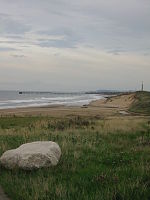Hart railway station
1839 establishments in England1963 disestablishments in EnglandDisused railway stations in the Borough of HartlepoolFormer North Eastern Railway (UK) stationsPages with no open date in Infobox station ... and 5 more
Railway stations in Great Britain closed in 1941Railway stations in Great Britain closed in 1953Railway stations in Great Britain opened in 1839Railway stations in Great Britain opened in 1946Use British English from February 2021

Hart railway station was a station that served the villages of Hart and Crimdon in County Durham, England. The station was built by the Hartlepool Dock & Railway as a stop on their main line between Hartlepool and Haswell but, under its successors, would later become a stop on the Hartlepool–Haswell–Sunderland, Hartlepool–Ferryhill and Durham Coast line.
Excerpt from the Wikipedia article Hart railway station (License: CC BY-SA 3.0, Authors, Images).Hart railway station
Hart to Haswell Walkway,
Geographical coordinates (GPS) Address Nearby Places Show on map
Geographical coordinates (GPS)
| Latitude | Longitude |
|---|---|
| N 54.7194 ° | E -1.2517 ° |
Address
Hart to Haswell Walkway
Hart to Haswell Walkway
TS27 3AA
England, United Kingdom
Open on Google Maps







